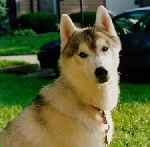
 |
Siberian Husky Rescue Site |
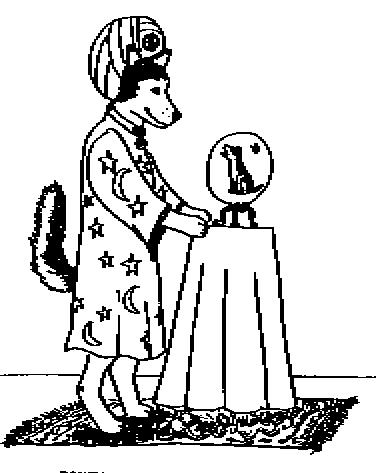
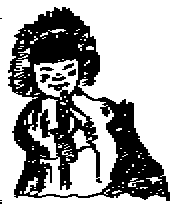
The Siberian Husky was originally bred by the Chukchi, a tribe of Siberian nomads, to provide fast, economical transportation over the vast frozen land. Unusually strong and agile, this medium size dog was able to swiftly cover long distances on a minimum amount of food. Known for its gentle nature, the Chukchi dog often served as a soft, furry bed for the tribal children. Chukchis knew many a "three dog night".
A special relationship born of mutual need and nurtured by mutual respect existed between this dog and its people, thriving in virtual isolation for centuries before the outside world discovered and fell in love with this magnificent animal.
Although the present day Siberian has changed since entering this country around 1900, the breed still maintains many of the qualities that made the Chukchi sled dog such a prized possession.
Adult and child alike are captivated by the Siberian's childlike eagerness, stately beauty, and million dollar smile. However, as appealing is the Siberian may be, it is not THE breed for every dog owner. Too many Siberians have ended up lost, in dog shelters, under the wheel of a car, the neighborhood nuisance, or mistreated simply because the owner did not understand the breed.
THE SIBERIAN HAS TRAITS AND
NEEDS THAT EVERY PROSPECTIVE OWNER SHOULD BE AWARE OF. Take a close
look at these traits--their advantages![]() and disadvantages
and disadvantages![]() --then decide if this is
the breed for you.
--then decide if this is
the breed for you.

![]() Siberian owners must build strong compounds and continually check for that tiny
hole, loose fencing, or gleam in their dog's eye that says, "I know something
you don't!" Remember: the term "escape proof" is not in the Siberian's
lexicon.
Siberian owners must build strong compounds and continually check for that tiny
hole, loose fencing, or gleam in their dog's eye that says, "I know something
you don't!" Remember: the term "escape proof" is not in the Siberian's
lexicon.
![]() or
or ![]()
 One glimpse into a Siberian "crater" is enough to realize how efficient a hole digger the Siberian is. Of course true
to the Siberian's nature, he will choose when and where to dig. This can present
a problem for many homeowners.
One glimpse into a Siberian "crater" is enough to realize how efficient a hole digger the Siberian is. Of course true
to the Siberian's nature, he will choose when and where to dig. This can present
a problem for many homeowners.
Siberians who do have a place to dig seem more content and
less destructive.
![]() The instinct to dig is ancient, and while it can be curbed to some extent, it
will not be eliminated.
The instinct to dig is ancient, and while it can be curbed to some extent, it
will not be eliminated.
![]() Siberians will dig and chew, outside or inside! If left to roam freely in the
house, the dog can turn a neat orderly home into a housekeeper's
nightmare.
Siberians will dig and chew, outside or inside! If left to roam freely in the
house, the dog can turn a neat orderly home into a housekeeper's
nightmare.
![]() One could call the Siberian a dog for all seasons, for its coat acts as
insulation against both heat and cold.
One could call the Siberian a dog for all seasons, for its coat acts as
insulation against both heat and cold.
![]() Sometimes criticized for housing his dog outside, the Siberian owner knows his
dog has been bred to flourish
Sometimes criticized for housing his dog outside, the Siberian owner knows his
dog has been bred to flourish in an outdoors situation.
in an outdoors situation.
![]() The housing needs of the Siberian are simple: clean kennel, fenced or stake-out
area, and a dog house.
The housing needs of the Siberian are simple: clean kennel, fenced or stake-out
area, and a dog house.
![]() The lovely thick coat that so efficiently protects the Siberian will shed
profusely several times a year, literally filling bushel baskets full of
hair.
The lovely thick coat that so efficiently protects the Siberian will shed
profusely several times a year, literally filling bushel baskets full of
hair.
![]() If you desire a true house pet, consider another breed.
If you desire a true house pet, consider another breed.

![]() The Siberian Husky
rarely barks, preferring to whine or moan, and when the mood is right, with head
held high, he will produce one of the most hauntingly beautiful sounds in
nature: The Siberian Howl.
The Siberian Husky
rarely barks, preferring to whine or moan, and when the mood is right, with head
held high, he will produce one of the most hauntingly beautiful sounds in
nature: The Siberian Howl.
![]() While this sound may be music to the ears of a Siberian lover, neighbors have
been known to feel otherwise.
While this sound may be music to the ears of a Siberian lover, neighbors have
been known to feel otherwise.
![]() or
or ![]() As a rule, the Siberian will not
alert his owner when a stranger approaches. While the owner is not bothered with
irritating barking every time someone enters his property, he is left without
that added protection. Many Siberian kennels have another breed specifically for
protection.
As a rule, the Siberian will not
alert his owner when a stranger approaches. While the owner is not bothered with
irritating barking every time someone enters his property, he is left without
that added protection. Many Siberian kennels have another breed specifically for
protection.
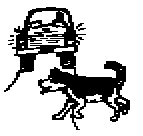
![]() The Siberian can easily
adjust to new environments.
The Siberian can easily
adjust to new environments.
![]() A
nomad at heart, the Siberian has no fear of cars nor homing instincts compatible
with our modern society, and once loose, he can easily fall prey to injury,
disease, and hunger, or become a pest chasing and hunting small animals or
digging in neighbors' yards. Siberian owners quickly learn that, for the dog's
sake, it must be confined or kept on lead at all times.
A
nomad at heart, the Siberian has no fear of cars nor homing instincts compatible
with our modern society, and once loose, he can easily fall prey to injury,
disease, and hunger, or become a pest chasing and hunting small animals or
digging in neighbors' yards. Siberian owners quickly learn that, for the dog's
sake, it must be confined or kept on lead at all times.
![]()
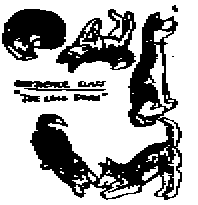 Given proper training, the Siberian should be able to obey simple commands and act quite respectable--most of the time.
Given proper training, the Siberian should be able to obey simple commands and act quite respectable--most of the time.
![]() Now we come to serious obedience training and the Siberian--something that
non-Siberian obedience people call a contradiction in terms. This is an
exaggeration, for the Siberian has the ability to perform admirably, and many
have. As a breed, however, they do not excel in this area, and anyone wanting a
dog solely for obedience work should not consider the Siberian.
Now we come to serious obedience training and the Siberian--something that
non-Siberian obedience people call a contradiction in terms. This is an
exaggeration, for the Siberian has the ability to perform admirably, and many
have. As a breed, however, they do not excel in this area, and anyone wanting a
dog solely for obedience work should not consider the Siberian.
Siberian people who do pursue obedience titles
tend to maintain a philosophical attitude towards the whole training
process--perhaps because they, like their dogs, tend to be gregarious and
well-behaved, but not always obedient enough for some.
![]()
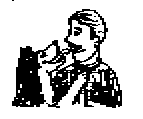 Siberians will greet almost
everyone, especially children, with the same unabashed joy that other dogs
reserve for special family members. To this gentle breed, all men are family for
they remember the Chukchi. Siberian owners respect this special
relationship.
Siberians will greet almost
everyone, especially children, with the same unabashed joy that other dogs
reserve for special family members. To this gentle breed, all men are family for
they remember the Chukchi. Siberian owners respect this special
relationship.
![]() Not everyone understands nor appreciates the demonstrative nature of the
Siberian. The owner must keep his dog under control, for no one appreciates a
big Siberian love hug when least expected or desired.
Not everyone understands nor appreciates the demonstrative nature of the
Siberian. The owner must keep his dog under control, for no one appreciates a
big Siberian love hug when least expected or desired.
![]()
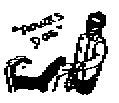 Because the Siberian has such a
gregarious nature, and despite its impressive strength and somewhat wolfish
appearance, this people-oriented breed should never be considered for
guard duty. Leave your home in the care of a "guard" Siberian and he will most
likely welcome an intruder with open arms, fetch (for the first time in his
life) your valuables and show him the best route of escape--after all, Siberians
are great escape artists.
Because the Siberian has such a
gregarious nature, and despite its impressive strength and somewhat wolfish
appearance, this people-oriented breed should never be considered for
guard duty. Leave your home in the care of a "guard" Siberian and he will most
likely welcome an intruder with open arms, fetch (for the first time in his
life) your valuables and show him the best route of escape--after all, Siberians
are great escape artists.
![]() or
or ![]() If you intend to acquire one and
only one dog, be aware of the rabbit syndrome--a rare and as yet incurable
malady that affects many Siberian owners. It usually starts with the desire to
own just one special Siberian, and before long, that one Siberian has turned
into two, five, or fifteen special Siberians. While Siberians can thrive in a
single dog environment, most prefer and many need the companionship of other
animals.
If you intend to acquire one and
only one dog, be aware of the rabbit syndrome--a rare and as yet incurable
malady that affects many Siberian owners. It usually starts with the desire to
own just one special Siberian, and before long, that one Siberian has turned
into two, five, or fifteen special Siberians. While Siberians can thrive in a
single dog environment, most prefer and many need the companionship of other
animals.
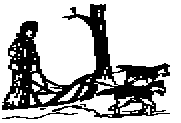
![]() The inquisitive
nature of the Siberian is one of the qualities owners find most endearing and
challenging.
The inquisitive
nature of the Siberian is one of the qualities owners find most endearing and
challenging.
![]() Curiosity not only kills the cat, but a sizable number of Siberians as well. The
desire to seek out that scent, to hunt, to chase, to discover the other side of
the fence, is primitive, deeply inbred, and can become overwhelming at the most
inappropriate moments. Ask any musher who has wrapped his/her sled around a tree
because the team decided to take the "scenic" route.
Curiosity not only kills the cat, but a sizable number of Siberians as well. The
desire to seek out that scent, to hunt, to chase, to discover the other side of
the fence, is primitive, deeply inbred, and can become overwhelming at the most
inappropriate moments. Ask any musher who has wrapped his/her sled around a tree
because the team decided to take the "scenic" route.
![]() This extremely powerful dog is a natural athlete, thriving on vigorous exercise.
The best exercise, of course, is in harness running on a team; however, your
Siberian will keep in shape with twenty minutes of hard play every other
day.
This extremely powerful dog is a natural athlete, thriving on vigorous exercise.
The best exercise, of course, is in harness running on a team; however, your
Siberian will keep in shape with twenty minutes of hard play every other
day.
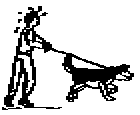
![]() It is a
misconception that the Siberian needs lots of open space. Adequate exercise can
be achieved within a fenced area no larger than the average yard.
It is a
misconception that the Siberian needs lots of open space. Adequate exercise can
be achieved within a fenced area no larger than the average yard.
![]() Perhaps no other breed has done more to keep his owner in shape than the
Siberian. How many hearty individuals would have been willing to trek through
knee deep snow with the temperature at -10 degrees F. before they owned that
Siberian?
Perhaps no other breed has done more to keep his owner in shape than the
Siberian. How many hearty individuals would have been willing to trek through
knee deep snow with the temperature at -10 degrees F. before they owned that
Siberian?
![]() Siberians must be confined or on lead at all times.
Siberians must be confined or on lead at all times.
![]() Because of their great strength, they should not be left solely in the care of
young children or less-than-physically-fit adults.
Because of their great strength, they should not be left solely in the care of
young children or less-than-physically-fit adults.
![]() Siberians love companionship and they will expect it regardless of the weather.
If you hibernate when the thermometer falls below 40 degrees F., reconsider
owning a Siberian.
Siberians love companionship and they will expect it regardless of the weather.
If you hibernate when the thermometer falls below 40 degrees F., reconsider
owning a Siberian.
![]() Few breeds are endowed with as much variety of coat and eye color as the
Few breeds are endowed with as much variety of coat and eye color as the Siberian. Match coats of velvet
black, subtle grey, or the many striking hues of copper with eyes of rich
chocolate brown, icy blue, or bewitching bi-color--every combination is a visual
delight.
Siberian. Match coats of velvet
black, subtle grey, or the many striking hues of copper with eyes of rich
chocolate brown, icy blue, or bewitching bi-color--every combination is a visual
delight.
![]() As with most natural beauties, the Siberian requires a minimal amount of care to
look gorgeous. Just run a comb through his coat once a week, bathe him several
times a year, and the fastidious Siberian will do the rest.
As with most natural beauties, the Siberian requires a minimal amount of care to
look gorgeous. Just run a comb through his coat once a week, bathe him several
times a year, and the fastidious Siberian will do the rest.
![]() Because the Siberian is so desirable and gregarious, he is easy prey for dog
snatchers.
Because the Siberian is so desirable and gregarious, he is easy prey for dog
snatchers.
![]() Originally bred to perform on a minimum amount of food, the Siberian requires
less substance per pound than other breeds his size.
Originally bred to perform on a minimum amount of food, the Siberian requires
less substance per pound than other breeds his size.
![]()
![]() Siberians need a
balanced diet, high in protein and fat--especially during the winter
months. Many commercial dog foods do not meet the dietary needs of the
Siberian.
Siberians need a
balanced diet, high in protein and fat--especially during the winter
months. Many commercial dog foods do not meet the dietary needs of the
Siberian.
After weighing all the pros and cons of owning a Siberian, do you still feel that it is the breed for you? If so, may we congratulate you on your good taste and offer some advice on choosing that special Siberian.
READ everything you can on the breed and its care. The history of the Siberian and the remarkable people who have shared its destiny make for fascinating reading, and even if you never own a Siberian, you cannot help but be impressed by this amazing dog's past.
MAKE SURE everyone in the household is aware just what to expect from the breed.
DECIDE whether you are willing to put up with the special needs of a puppy--or would an adult dog better suit your lifestyle? There are many adult Siberians waiting to be rescued. Check out the Siberian Husky listing of available dogs in your area.
CONTACT the local affiliate of the AKC or, if you know it, the local Siberian Husky kennel club, for names of breeders in your area. If you are interested in a rescue dog, visit your local shelter or the Siberian Husky rescue site for names and contact information for your area.
VISIT several kennels before choosing one. Inspect the dogs and their environment. If possible, ask to see both the sire and the dam of any dog you are considering, and make sure their eyes and hips have been certified clear. Some kennels have temperament testing done on their litters, and this may help you in the choice of a puppy. Most important, take your time and be sure of your choice.
Having decided on the Siberian, make sure that everything you and the breeder/owner agree to is IN WRITING. This should include, but not necessarily be limited to, the following: price of dog, sire and dam and their AKC registration numbers, limited guarantee on the dog, and vaccination records. It is suggested that the purchaser have the dog examined by his/her veterinarian within ten days.
GET as much INFORMATION on the care and feeding of your dog from the owner/breeder as possible.
Once your dog is home, don't forget to KEEP UP WITH the needed IMMUNIZATIONS. In addition to the required inoculations, your dog should be protected against Parvo and Heartworm. All Northern breeds are susceptible to certain parasites; be aware of their symptoms and have your dog's stools checked periodically.
Your Siberian is the product of CENTURIES OF CAREFUL, PURPOSEFUL BREEDING. As a Siberian owner, it is now your responsibility to maintain this standard of excellence. We advise neutering all Siberians sold solely as pets. There is an abundance of excellent Siberians, and any indiscriminate breeding not only adds to the already serious pet population problem, but can lead to serious genetic problems for future generations.
There is even a logical explanation for the Siberian's seemingly casual indifference to commands. The Siberian can easily sense any uncertainty or nervousness you may be experiencing and will quickly question your leadership ability. Every breed is guided to one degree or another by the pecking order, and while some breeds will submit more quickly to the will of man than others, the Siberian will insist you prove a good and reliable leader before he accepts your dominance. The Siberian will always give freely of his love and affection. However, his respect must be earned.
As you gain confidence, become more skilled in handling dogs, and acquire some Siberian tricks of your own, you will probably find your Siberian listening and, yes, even obeying more.
Given generous amounts of love, plus proper care and training, your Siberian will give you years of enjoyment--Siberian style, of course.
This site is a reprint of a pamphlet prepared by the Seneca Siberian Husky Club, a group of people dedicated to the promotion of better understanding and protection of the breed we love so dearly. It is reprinted here with permission of the Club Secretary, Janet Triplett. Janet requests that if you find this material useful and plan to distribute it to others you send a donation to the club at the following address:
SENECA SIBERIAN HUSKY CLUB
c/o Pat Kingsley, Newsletter Editor
1475 Latta
RoadRochester, NY
14612
Illustrations by
Sharon P. Scott
Text by Nancy B.
Kaplan
Copyright 1983 by the Seneca Siberian Husky Club, all rights reserved.
| Corrections (like typos) to this information should be sent to: editor@siberianrescue.com . |
 Return to Siberian Husky Rescue Home
Page Return to Siberian Husky Rescue Home
Page |